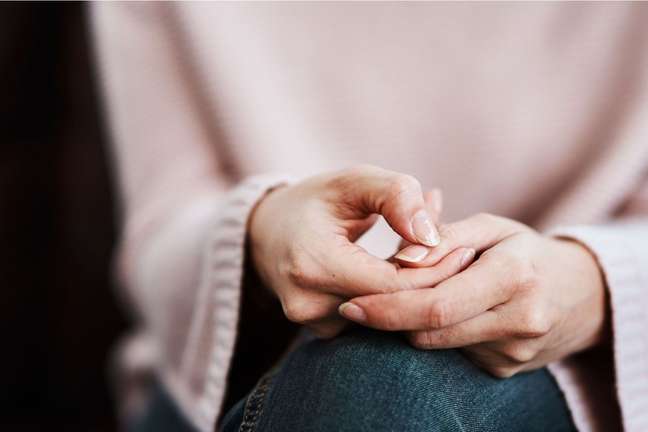Skin cuts are a way for young people to cope with emotional pain, but the behavior inspires care
Common among teenagers, self-mutilation they worry parents and teachers. Skin cuts are a way young people have found to deal with emotional pain, but they inspire healing. To guide families and educators on the problem, specialists linked to the University of Sao Paulo (USP) have launched a guide with suggestions: the main message is to empathize with the feelings of young people.
The booklet was published by psychiatric nursing specialists at USP Ribeirão Preto College of Nursing. The document provides indications of care, approach and reception. Among the warning points is the relationship between self-harm and social networks.

According to the guide, the Internet exposes methods and photos of self-inflicted wound, causing a mimetic or triggering effect for those who are emotionally vulnerable. “The situation in networks is dangerous because it can put people who need help in that same environment,” says USP professor Kelly Graziani Giacchero Vedana.
Young people listened to Estadio they attribute self-injurious behavior to several factors, but claim they see the influence of what they watch on the Internet. “I thought I was the only one doing it, and then I saw other people (on social networks) and I started talking to them. This was creating a snowball and affecting me more, I saw the photos and it made me sick. I took it with myself and it got worse, ”says 24-year-old student Maria (she’s not her real name), who she cuts from her when she was 13.
The act of transforming mental suffering into physical pain is a behavior called self-harm: the person harms himself intentionally and repeatedly without the purpose of suicide. Self-injuries are more common in adolescence: 23.3% of events are in the 15 to 19 age group, according to data from the Ministry of Health in 2021.
Among the different types of self-harm are the attitudes of cutting, burning, hitting the head, scratching, punching objects and preventing wounds from healing. The main purpose is to cope with emotions or endure difficulties in social relationships. “It is the simplest way I have found to eliminate my anger, my anguish, my sense of guilt,” adds Maria.
Aline Conceição da Silva, a PhD student at USP who prepared the booklet during her research at the university, explains that the resource is normally used as a relief, especially for those who are still understanding their emotions. “Adolescence is the time when there are different feelings that these young people still don’t know how to deal with; they use self-harm as a mechanism to deal with them,” she says.
She, who specializes in the prevention of provoked violence, clarifies that the behavior is aimed at communicating suffering, resolving a conflict or even being a means of preventing suicide. Although common among young people, self-harm can occur at any stage of life, from infants to the elderly.
Signs and risk factors for self-harm
Hormonal disruptions, impotence, low self-esteem, childhood abuse, abuse, physical and emotional neglect are among the risk factors for self-mutilation. Mental disorders, family instability, lack of friends, bullying, suicide stories, feelings of not belonging, violence, shame, and prejudice also influence self-harm.
Clara, a psychology student (not her real name), 25, says family quarrels and her parents’ separation were factors that made her start hurting herself when she was 11. “I’ve always been a little girl with a dysfunctional family,” she says. “Somehow I blamed myself and started getting hurt.”
According to experts, it is important that the family and the school are aware of changes in behavior, in school performance and in relationships with relatives and friends: “It is normal that they tend to distance themselves a little more or even publish outbursts on social network to verbalize this suffering. At this point lies the importance of friends, who can collaborate in the perception of this problem “, explains Aline.
What to do in case of self-harm
From the moment self-harm is identified, the first step is to welcome, respect the young person’s privacy, and validate his or her feelings. It is important to change the belief that self-harm was done to get attention. Young people should also be encouraged to express themselves, understand moments of silence and understand how they intend to be helped.
Support from family members, according to the brochure, should be more focused on the teen’s feelings than on the wounds themselves. This is because focusing solely on injuries reinforces self-injurious behavior. On the other hand, hyper vigilance to try to prevent further self-harm can also have a negative impact. Excessive restrictions can generate in young people a feeling of less autonomy and a new load of stress.
“Once we recognize self-harm, we need to seek the help of a healthcare professional. It’s very difficult to know that someone we love is being hurt, so we also take care of parents and friends,” explains Aline. In case of more serious injuries, it is recommended to call an emergency service.
In psychiatry studies it is normal for young people to arrive, brought by their parents, in despair, after the family has discovered the cuts, says the psychiatrist of children and adolescents Jackeline Giusti, coordinator of the Outpatient Clinic for adolescents at the Institute of Psychiatry ( IPq) at Hospital das USP clinics.
“When we go to evaluate, it can be a family situation of very demanding parents, but very often there is an associated depressive condition,” says Jackeline. The good news is that by treating what is causing the emotional pain, self-harm tends to decrease. “Sometimes, just by talking to the patient, giving a name, saying ‘look, you are depressed, there is a treatment, we will help you’, the self-harm stops.”
Here’s how to deal with self-harm:
- Use a calm tone in your communication
- Demonstrate concern for the well-being of the adolescent
- Ask respectful questions that invite children to share their feelings and avoid intrusive questions
- Understand that it takes time for the teen to feel comfortable sharing emotions
- Do not focus conversations on the acts of self-harm, but on the feelings and stressors that anticipate the acts
- Share sincere feelings about how they feel about self-harm, being careful not to instill guilt
- Avoid “solving” the problems presented by young people, but collaborate in the autonomy of the young person to solve the problems
- Understanding that “sermons”, accusations and punishments are not the best ways to bring about positive and lasting change
The researchers also stress the role of social networks in curbing the spread of content that encourages self-mutilation. “It is important that we have initiatives from the platforms themselves to minimize these problems, such as inserting help buttons and removing the visibility of content that causes this negative effect,” Aline points out.
Platforms consulted by Estadio highlight the measures already taken to prevent this content from being broadcast. Instagram, for example, claims to have rules that don’t allow sharing of content that promotes suicide or self-harm. “Neither We allow content related to fictional methods, materials and content that uses drawings or memes to encourage or display depictions of suicide or self-harm. This type of content is removed as soon as it is identified. “In the first quarter of 2022, the platform acted on 5.1 million suicide and self-harm content on Instagram.
Myths and truths about self-harm
Myth: Behavior is for attention
Truth: Self-harm can signal emotional distress that really needs treatment
Myth: It is a typical behavior of adolescence and it passes with time.
Truth: The behavior has potentially lasting physical and emotional repercussions and requires professional follow-up and a support network
Myth: Violence must be used to stop self-harm
Truth: Punishment and violence can fuel emotional suffering, leading to intensification of self-harm
Myth: The previous generation was more mature and able to cope with problems
Truth: Each generation faces different contexts; not making comparisons is respecting the suffering of the other
Myth: The family is responsible for the adolescent’s lack of education and limitations
Truth: Self-harm has multiple factors; I can’t blame anyone
Myth: Self-harm is a failed suicide attempt.
Truth: Self-harm does not have suicidal intent, but it can occur in conjunction with suicidal behavior. Risk assessment and professional follow-up are required
How to get help for people who self-harm
To help people who self-mutilate, SUS has a psychosocial assistance network. People can go to the closest Basic Healthcare Unit (UBS) to their home free of charge; The Life Appreciation Center (CVV) is a voluntary emotional support service that provides free assistance to those who need to speak. The service is provided by phone 188, via email and on-site chat 24 hours a day.
There are also first aid booklets for mental health to welcome people in emotional crisis and the “Pode Falar” channel with the care of people aged 13 to 24. In case of criminal posts that influence self-harming or suicidal behavior, it is possible to report them on the SaferNet platform.
Source: Terra
Benjamin Smith is a fashion journalist and author at Gossipify, known for his coverage of the latest fashion trends and industry insights. He writes about clothing, shoes, accessories, and runway shows, providing in-depth analysis and unique perspectives. He’s respected for his ability to spot emerging designers and trends, and for providing practical fashion advice to readers.




![Un Si Grand Soleil preview: Thursday, October 23, 2025 episode recap [SPOILERS] Un Si Grand Soleil preview: Thursday, October 23, 2025 episode recap [SPOILERS]](https://fr.web.img6.acsta.net/img/12/a9/12a96513d7a4f6120d33b7120427505f.jpg)


